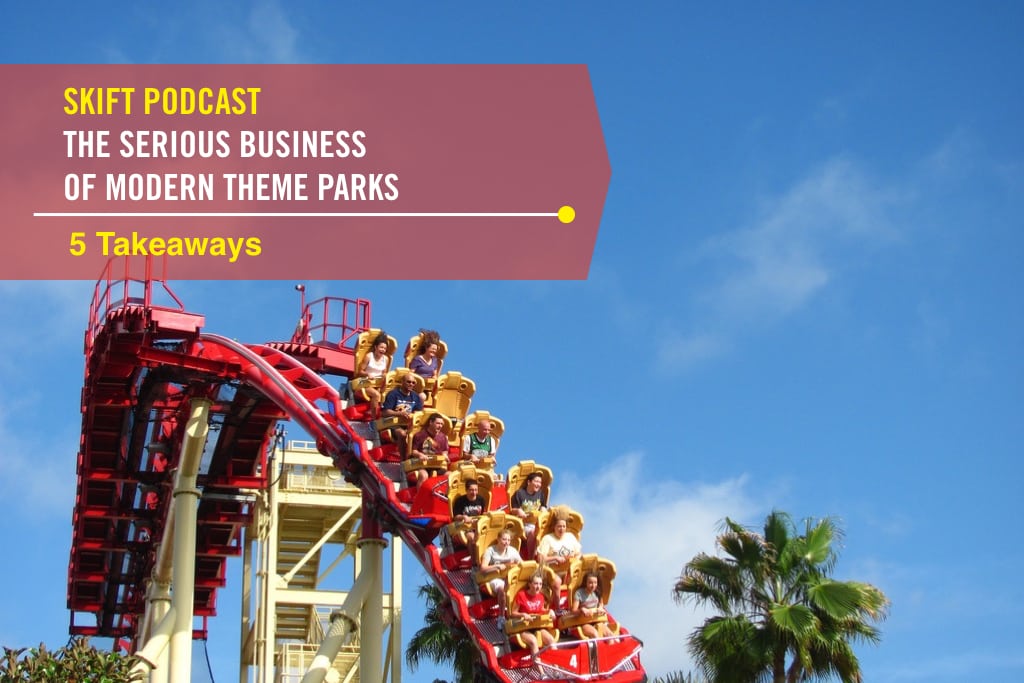Skift Take
Today's theme parks are a far cry from the previous generation. Disney is still setting the pace, but the offerings, pricing, and technology are evolving fast.
We looked at theme parks for a recent episode of the Skift Podcast, in which we explored how today’s parks have little in common with the previous generation. Leadership is raising prices, using technology, and diversifying products in new ways.
Our guests were Farmingdale State College professor Martin Lewiston, who studies the theme park industry, and Robert Niles, founder and editor of the website Theme Park Insider. They joined host Hannah Sampson and Skift reporter Dan Peltier.
Here are five takeaways from the conversation:
Ticket prices are reaching a threshold.
The price of tickets has gone up dramatically over the years, and now, many families can’t afford to visit on a regular basis, if at all. Some parks are honing in on the luxury market as well.
“There’s a Four Seasons at Walt Disney World now. That pretty much tells you what you need to know,” said Niles.
Theme parks may even lean toward airline- or hotel-style pricing, i.e. dynamic pricing, in order to maximize revenue.
“You do see some of the larger chains, Six Flags and Cedar Fair, are starting to realize, ‘Oh, weekends are busier than the weekdays,’ which seems such a no-brainer, but they’ve only really just started to do that,” said Lewison. “To be honest, I think they wait for Disney because Disney can kind of pave the way.”
China is the big growth market in global tourism, and that includes theme parks.
China is still a new market for many travel brands and Shanghai Disney in some ways is blazing the trail. There’s much optimism about China, but it’s more difficult than just landing there.
On Disney in China, Niles said, “They’ve got some pretty sophisticated tools, and quite a bit of consumer analysis of the Chinese market in all their other operations, films, television, everything else that they do in the Disney company. I think they’ll figure it out relatively quickly, but it’s still going to take them a couple of years.”
Intellectual property is crucial, but only if it’s strong.
Experiences based on Harry Potter, for example, have been a cash cow for Universal, while SeaWorld struggles with the fact that their IP, chiefly Shamu, is surrounded by negative publicity.
On SeaWorld, Niles said, “I think the two biggest things that they had were free beer, when they were part of Anheuser-Busch, and then the iconic moment of when the trainer would launch off the Orca’s nose 30 feet into the air. Well, after Dawn died in 2010, OSHA took that away, so they didn’t have their iconic moment, they didn’t have the free beer, and Harry Potter opened up the road at Universal, so everybody spent their non-Disney day on their Orlando vacations going to Universal instead of SeaWorld.”
“I think the days of being able to slap some old wood on the walls and call it Old Western Town are gone,” said Lewison.
The potential of virtual reality is questionable.
Many travel brands are anxious to jump on the VR bandwagon, and theme parks recognize it as an inexpensive way to revitalize an existing ride.
“I think it’s a fad,” said Lewison. “I think it’s a temporary way to add something new. Your audiences are looking for something new every single year… This is a relatively cheap, low capital investment way to create a new experience.”
Niles was more optimistic about execution. He said of trying a VR ride himself, “I loved it, actually. I was really surprised. I went into it with a very high level of skepticism. I thought I was going to be green when I came off of that thing, totally sick. It turns out that it was actually more comfortable than I expected.”
As it stands, SeaWorld is no longer competing with Disney and Universal.
Due to allegations of animal cruelty, brought into the mainstream by the documentary Blackfish, SeaWorld has slid in terms of attendance and financial viability. Now, it looks much more like a regional park than in league with Disney.
“This has been some of the most disappointing theme park management I have seen,” said Niles. “This is a capital-intensive business. SeaWorld always had aspirations of competing with Disney. They always saw themselves on the same level, maybe even a little bit above Universal, but those two companies are part of multibillion dollar corporations, with almost bottomless access to capital and IP. SeaWorld on its own now, now that it’s been IPO’d off of Blackstone.”
At the same time, SeaWorld’s response to Blackfish was lackluster at best, and they missed a major opportunity to try to bounce back.
Niles continued, “When Blackfish came out, there was so much to criticize about that movie. I mean, there’s so much in there that was just frankly wrong, misleading editing. SeaWorld eventually came up with this really compelling blow-by-blow refutation of the film, six months after it came out. They put it into a PDF that they buried on their website… They just went into a shell and just didn’t respond, they weren’t proactive. They weren’t aggressive with their marketing.”
The Daily Newsletter
Our daily coverage of the global travel industry. Written by editors and analysts from across Skift’s brands.
Have a confidential tip for Skift? Get in touch
Tags: disney, podcast, seaworld, skift podcast, theme parks, universal
Photo credit: A roller coaster at Universal Studios Florida. Theme parks are upping the game across the world — and raising prices to new highs. Roller Coaster Philosophy / Flickr
